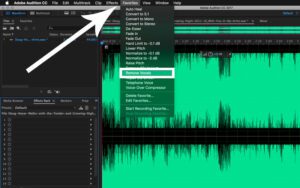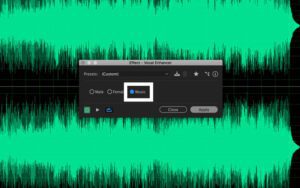Many people think that video is merely a visual medium and often overlook the wonderful world of audio. When you watch a film, a show, or a commercial, you listen to it, too. Audio is a crucial part of filmmaking, and no sound grabs the attention of the viewer more than the human voice. Voice-overs have been countlessly used to enhance the visual experience, and now adding vocals to video has never been easier.
Of course, there’s a lot that goes into vocal recording, and you need to know a few things before you get started. If you’re just starting out, the world of vocal recording can be a bit confusing. What gear do I need? How much will it cost? How do I get the best out of my recording? Fortunately for you, we’ve gathered all the information you need to add vocals to video and put it all into one post. We’ll go over recording basics, the best gear to get the job done, and some extra tips and tricks to take your recordings to the next level.
How to Record Vocals
First, it’s impossible to record vocals without the right gear. You need recording equipment in order to record and get professional sounding voice-overs. Here are the basics of what you’ll need:
- Microphone
- Pop Filter
- Mic stand
- Cables
- Audio interface
- Headphones
- Computer
- Digital Audio Workstation (DAW)
OK, maybe you need a lot of things. While this may look overwhelming on paper, all of the gear fits together to make one coherent recording station. Of course there are other audio recording set-ups, but this one is the most universal, and is widely considered the best way for getting the most out of your vocals.
If you want to skip the hassle of finding each of these items individually, Focusrite’s Scarlett 2i2 studio bundle comes with all the equipment you need at a steal of a price. However, it’s still important to know what each of these individual items does in a recording station, so bear with us while we get a little technical.
- The microphone is a device that converts sound from analog to electrical signals.
- A pop filter prevents puffs of air and hissing from interrupting and ruining your recordings. This usually happens when making P and S sounds.
- The mic stand is a little self-explanatory–it holds the mic.
- Cables connect the microphone to the audio interface and then to the computer.
- The audio interface is responsible for converting analog signals into digital signals so the computer can read and record the audio.
- Headphones simply let you monitor what’s being recorded as you talk or sing into the mic.
- Last, but not least, a digital audio workstation (DAW) is vocal recording software that also allows you to edit your recordings.
Even though there’s a lot of gear you need to get started, it all comes together to form one solid recording station, and you can easily find gear that is both high in quality and low in price. We could go on and elaborate about each of these items for days, but for the sake of time we’ll just go over two of the more complicated pieces of equipment: the microphone and the DAW.
The Best Microphone for Recording Vocals
Vocals are like a rollercoaster of sound—they can be high or low, rough or smooth, loud or soft. And while there are an endless amount of types and styles of microphones, the best for picking up the full range of the human voice is the condenser mic. It’s pick-up pattern and large diaphragm is what makes it so great for recording vocals.
Depending on who you ask, you’ll get a thousand different answers to which microphones are best for recording vocals. Condenser mics are used in almost every recording studio, and they are perfect tools for adding vocals to video.
The Best Digital Audio Workstations
There’s a lot of debate over DAWs and which one is the best, but there isn’t a clear-cut answer because everyone’s preferences and recording needs are different. No one DAW is superior over another, and you can accomplish the same effects and the same outcomes no matter which one you use.
We find that the best DAW is the one most easily available to you. Most audio interfaces come packaged with a DAW, making that software a great place to start. However, if you are going to take vocal recording and audio editing seriously, then these DAWs are some of the highest rated in the industry:
Of course there are several more out there—too many to list here. And don’t think that you can’t create great sounding vocal recordings without these DAWs. You can accomplish professional results with more basic DAWs like GarageBand and Audacity—it just takes a little practice.
Now, before we go any further, we can’t write about adding vocals to video without mentioning Adobe Audition. This software has traditionally been a simple digital audio editor, but with recent updates it can be used as a full-fledged DAW. Audition, like most Creative Cloud apps, is connected to Adobe Premiere—so you can easily transfer audio to and from the video editor. This does wonders for workflow, and you can cut your editing time in half. Adding vocals to video has never been easier.
How to Remove Vocals from a Song
Believe it or not, too much vocals can be a bad thing. For instance, playing a song with lyrics while playing a voice over at the same time can be a bit distracting. But maybe that song fits the mood of your video so perfectly that you just have to use it. If the song is a must, then you’re in luck because removing vocals from a song couldn’t be any easier—just use Adobe Audition.
Audition has it’s own vocal remover effect that does the work for you. With this tool, you can turn almost every lyrical song into an instrumental. In order to remove vocals from a song, check out this step-by-step mini tutorial. If you want to follow along, download this song from our library of royalty free music and see for yourself just how powerful this effect can be.
Step 1: Import the Audio File

Step 2: Go to the Favorites Tab and Select Remove Vocals

Step 3: Refine the Sound with the Vocal Enhancer Effect


Note: Make sure you select the music option.
Unfortunately, this effect won’t work 100% of the time simply because the software has to cut out some of the frequency in the music in order to remove all of the vocals. In this case, you can either lower the volume of the music altogether, time your edit so that the vocals don’t play at the same time, or find an instrumental to fit your project from our vast library of stock music.
That’s about it! Now that you know everything you need to record high quality vocals, it’s time to make something great. With the help of some stock footage to compliment your voice-over and stock music to set the tone, the possibilities are endless.



